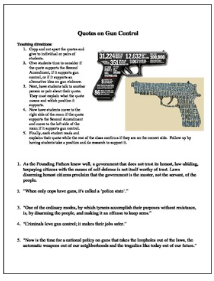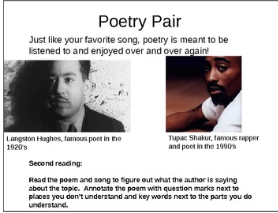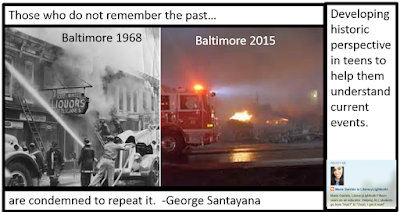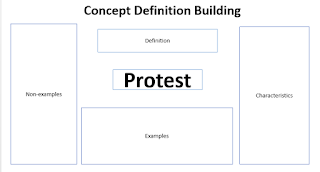Teacher Cred: What is it? Why is it important? How can you earn it?
What is Teacher Cred?
I grew up in the 90's, listening to artists like Dr. Dre, Tupac, and Eminem. For these rappers, street cred was extremely important- being true to where you came from and representing the neighborhood accurately was at the heart of the lyrics. I won't pretend to know all the nuances of street cred or pretend that I have it, but I will borrow the term cred and show how Teacher Cred is necessary for teaching and reaching struggling adolescents.
The word part cred is Greek for belief and is in words like credit, credentials, and creed. Having teacher cred means having your students' respect- they believe in you as a teacher.
Why is Teacher Cred important?
It is well documented that students work harder for teachers they like, teachers they respect-- teachers that have Teacher Cred. Struggling students in particular have had a history of failing at reading and have heard it all before. Each year they hope things will be different, but by the time they are in late middle school they have lost faith in their teachers--you have to prove them wrong. You need to earn Teacher Cred.
How Can you Earn Teacher Cred?
The older your students are, the more difficult and the longer it takes to develop. Older struggling students often "test" their teachers to see if they really know their stuff and if they will keep their word. Here are a few ways of earning your Teacher Cred. Please excuse the use of slang, it is for effect!
1. You need to "have their backs"
When you have someone's back, you are on their side through thick and thin. Students need to know that even on the days that your patience is wearing thin, that you are still there for them. A simple way to develop relationships with students is the two minute rule. Talk to students for two minutes, as they enter the room, during Do Now time, during independent work. Think of it as an investment. Spending two minutes asking a student about her weekend now, will improve her attention in your class, her motivation, and her behavior in the future.
I remember a student from years ago... He was often in trouble in his classes, kicked out from one class and in another. Kevin just left my class where I reprimanded him several times for not being on task and he came back after class ended because his next teacher kicked him out. When my class was working on their Do Now I walked over to him an asked what happened. I talked with him about the misunderstanding he had with his other teacher and then he said, "Ms., how come you always still care even when you are mad at me?"
Too often students aren't given a clean slate. Kids are kids--they are going to get in trouble, mess up, disrespect, make poor decisions, make their parents and teachers lose their patience--and sometimes their tempers. The adults in their world can't take it personal, these are teachable moments--and perfect opportunities to earn some Teacher Cred.
2. You need to "keep it real"
When you "keep it real" you are true to who you are and not "putting on a front", or being fake. Students will see right through empty threats. Say what you mean and mean what you say. If you make a mistake, admit it and simply say sorry and move on.
Another facet of "keeping it real" is transparency. Letting students understand why they are doing something is incredibly important. Too often struggling students are given busy work that is not important to their growth.
I had a turning point with one of my students not too long ago... He burst out "You are always picking on me!" and he put his head on his desk. Instead of reprimanding him or ignoring it I told him, "You know, sometimes I feel like you are picking on me too." He looked up, surprised. "When I am talking it seems like you are being disruptive on purpose. We really need a better way of getting along for us to work together." I asked him to tell my why he though I was picking on him---basically he didn't like when I reprimanded him in from of the class--so I let him know that I would work on that and use signals instead, or talk to him personally. I told him that I needed him to pay more attention and not talk when I am. We came up with a rating system and "graded" each other at the end of class. After this, his behavior improved dramatically--he appreciated the authenticity of the conversation and my sincere intention to improve, so he improved too.
3. You need to "give them props"
How Can you Earn Teacher Cred?
The older your students are, the more difficult and the longer it takes to develop. Older struggling students often "test" their teachers to see if they really know their stuff and if they will keep their word. Here are a few ways of earning your Teacher Cred. Please excuse the use of slang, it is for effect!
1. You need to "have their backs"
When you have someone's back, you are on their side through thick and thin. Students need to know that even on the days that your patience is wearing thin, that you are still there for them. A simple way to develop relationships with students is the two minute rule. Talk to students for two minutes, as they enter the room, during Do Now time, during independent work. Think of it as an investment. Spending two minutes asking a student about her weekend now, will improve her attention in your class, her motivation, and her behavior in the future.
I remember a student from years ago... He was often in trouble in his classes, kicked out from one class and in another. Kevin just left my class where I reprimanded him several times for not being on task and he came back after class ended because his next teacher kicked him out. When my class was working on their Do Now I walked over to him an asked what happened. I talked with him about the misunderstanding he had with his other teacher and then he said, "Ms., how come you always still care even when you are mad at me?"
Too often students aren't given a clean slate. Kids are kids--they are going to get in trouble, mess up, disrespect, make poor decisions, make their parents and teachers lose their patience--and sometimes their tempers. The adults in their world can't take it personal, these are teachable moments--and perfect opportunities to earn some Teacher Cred.
2. You need to "keep it real"
When you "keep it real" you are true to who you are and not "putting on a front", or being fake. Students will see right through empty threats. Say what you mean and mean what you say. If you make a mistake, admit it and simply say sorry and move on.
Another facet of "keeping it real" is transparency. Letting students understand why they are doing something is incredibly important. Too often struggling students are given busy work that is not important to their growth.
I had a turning point with one of my students not too long ago... He burst out "You are always picking on me!" and he put his head on his desk. Instead of reprimanding him or ignoring it I told him, "You know, sometimes I feel like you are picking on me too." He looked up, surprised. "When I am talking it seems like you are being disruptive on purpose. We really need a better way of getting along for us to work together." I asked him to tell my why he though I was picking on him---basically he didn't like when I reprimanded him in from of the class--so I let him know that I would work on that and use signals instead, or talk to him personally. I told him that I needed him to pay more attention and not talk when I am. We came up with a rating system and "graded" each other at the end of class. After this, his behavior improved dramatically--he appreciated the authenticity of the conversation and my sincere intention to improve, so he improved too.
3. You need to "give them props"
When you "give someone props", you are giving them their proper respect, or acknowledgement. Students need to be recognized for the positive things they do, not just criticized for the negative. There was a study done on the differences between students in low and high socioeconomic settings. One major difference was the type of feedback they received. Children in low socioeconomic settings hear negative feedback nearly five times more than those in higher socioeconomic settings.
In addition to keeping things positive with our students, they also need be given respectful instruction. I have seen teachers, with the best of intentions, give their struggling students much easier work than they give others. On the surface, it seems like the best thing to do--they are struggling after all, so an easier task is in their best interest. You don't want to frustrate them, right? I have found the exact opposite to be true. These kids are savvy, they know if they are being given dumbed down work. The single best thing we can do for all of our students is to hold them to high expectations and build their strategies and skills to help them reach those lofty goals.
A few years ago, I talked to two men that I know who dropped out of high school when they were younger. They do not know each other and I spoke to them separately, on two different occasions. I asked them why they dropped out--their answers were strikingly the same. They dropped out because they didn't like being treated like they were "dumb" and "bad". Both of them said that their teachers didn't teach them, just let them fail.
Teachers often say "I taught it but they did not learn it!" It was not truly taught is the students did not learn it. Using formative assessment throughout the lesson and unit, breaking it down to smaller steps can help teachers make sure that the students are learning it. When students have not mastered the material, teachers with Teacher Cred continue to revisit the material until everyone has learned it. Interestingly, one of the top factors of dropping out of school is academic performance--specifically in Reading and Math. Helping students master these subjects just may keep them on the right track.
It is said that teaching is all about relationships--having Teacher Cred is the pinnacle of building relationships with students, especially your struggling learners. With that said, here is a list of what Teacher Cred IS and IS NOT:
Teacher Cred IS NOT...being friends with your students.
Teacher Cred IS...being a warm, demanding adult that provides your students with the guidance that they need.
Teacher Cred IS NOT...being the "fun" teacher who gives "easy" work.
Teacher Cred IS... being the firm but fair teacher who gives students challenging and engaging work and puts in extra effort to help students when they need it.
Teacher Cred IS NOT... getting down to the students level and using slang and teaching only the things students can relate to.
Teacher Cred IS...being professional at all times (only using slang in the occasional blog post ;) )and raising the bar for students by helping them see the relevance of rigorous curriculum material to their lives.
So...have you earned Teacher Cred today?
In addition to keeping things positive with our students, they also need be given respectful instruction. I have seen teachers, with the best of intentions, give their struggling students much easier work than they give others. On the surface, it seems like the best thing to do--they are struggling after all, so an easier task is in their best interest. You don't want to frustrate them, right? I have found the exact opposite to be true. These kids are savvy, they know if they are being given dumbed down work. The single best thing we can do for all of our students is to hold them to high expectations and build their strategies and skills to help them reach those lofty goals.
A few years ago, I talked to two men that I know who dropped out of high school when they were younger. They do not know each other and I spoke to them separately, on two different occasions. I asked them why they dropped out--their answers were strikingly the same. They dropped out because they didn't like being treated like they were "dumb" and "bad". Both of them said that their teachers didn't teach them, just let them fail.
Teachers often say "I taught it but they did not learn it!" It was not truly taught is the students did not learn it. Using formative assessment throughout the lesson and unit, breaking it down to smaller steps can help teachers make sure that the students are learning it. When students have not mastered the material, teachers with Teacher Cred continue to revisit the material until everyone has learned it. Interestingly, one of the top factors of dropping out of school is academic performance--specifically in Reading and Math. Helping students master these subjects just may keep them on the right track.
It is said that teaching is all about relationships--having Teacher Cred is the pinnacle of building relationships with students, especially your struggling learners. With that said, here is a list of what Teacher Cred IS and IS NOT:
Teacher Cred IS...being a warm, demanding adult that provides your students with the guidance that they need.
Teacher Cred IS NOT...being the "fun" teacher who gives "easy" work.
Teacher Cred IS... being the firm but fair teacher who gives students challenging and engaging work and puts in extra effort to help students when they need it.
Teacher Cred IS NOT... getting down to the students level and using slang and teaching only the things students can relate to.
Teacher Cred IS...being professional at all times (only using slang in the occasional blog post ;) )and raising the bar for students by helping them see the relevance of rigorous curriculum material to their lives.
So...have you earned Teacher Cred today?






























